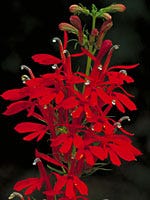by Suzanne DeJohn

To drive around some neighborhoods, you'd think that the only plants that will grow in shade are hostas and impatiens. Yes, these are lovely plants, but there's a whole world of other shade-loving plants out there! If you're looking to expand an existing shade garden, or you're tired of struggling to grow lawn or sun-loving plants in a shady spot in your landscape, consider planting some woodland wildflowers.
Why Native?
There's something particularly rewarding about growing native woodland wildflowers. You not only get to enjoy the beauty of their blooms, you also provide food and shelter for native wildlife. For example, columbines and cardinal flowers attract hummingbirds, and wintergreen berries provide winter food for partridges and bobwhites. Native plants have adapted to the particular conditions of their region of origin. While some types can be finicky about where they're planted, others rival garden stalwarts like daylilies in their adaptability.
 Wildflowers Big and Small When choosing plants for your garden, you always want to consider their mature size. This holds true for woodland wildflowers, too. Like other perennials, these flowers range in size from ground-hugging dwarf iris and hepatica that might reach 8 inches in height, to towering black cohosh and turk's cap lily that can grow to 5 feet or taller.
Wildflowers Big and Small When choosing plants for your garden, you always want to consider their mature size. This holds true for woodland wildflowers, too. Like other perennials, these flowers range in size from ground-hugging dwarf iris and hepatica that might reach 8 inches in height, to towering black cohosh and turk's cap lily that can grow to 5 feet or taller.
 Location, Location Some wildflowers, including cardinal flower and spiderwort, grow best in consistently moist soil. Save them for waterside plantings or low spots in your landscape. Red trillium, in contrast, readily adapts to most soils. Remember the gardener's adage, "Right plant, right place."
Location, Location Some wildflowers, including cardinal flower and spiderwort, grow best in consistently moist soil. Save them for waterside plantings or low spots in your landscape. Red trillium, in contrast, readily adapts to most soils. Remember the gardener's adage, "Right plant, right place."
Fall Planting for Spring Bloom Like many perennials, fall is a good time to plant woodland wildflowers. This is especially true of plants that bloom in spring, including Jack-in-the-pulpit and Virginia bluebells. Setting these plants out in fall gives the roots plenty of time to settle in and get established so the plants are ready to burst into bloom in spring.
 Propagated vs. Wild All our woodland wildflower plants are nursery propagated. Why is this important? Because over the years some unscrupulous people have sold plants they dug up from the wild, devastating large swaths of native wildflowers and disrupting the woodland ecology. Some of our loveliest native wildflowers are now rare because of over-harvesting. You can rest assured that none of the plants we sell were harvested from the wild.
Propagated vs. Wild All our woodland wildflower plants are nursery propagated. Why is this important? Because over the years some unscrupulous people have sold plants they dug up from the wild, devastating large swaths of native wildflowers and disrupting the woodland ecology. Some of our loveliest native wildflowers are now rare because of over-harvesting. You can rest assured that none of the plants we sell were harvested from the wild.